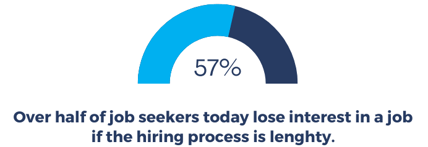How can I cut down on recruitment costs?
This is a question often asked by employers, hiring managers and recruiters – and for good reason.

Advertising job postings, screening dozens of applications, interviewing virtually or in-person, onboarding and training new candidates can add up to spending a lot of time, energy and – of course – money. In fact, the cost of recruiting and hiring a single employee could be as much as £30,000, according to an analysis from Oxford Economics.
But what if we told you that there are ways you could optimise the cost of hiring?
For the first part of our Recruitment Guide, we shared insights on how much finding, hiring and losing an employee actually costs you, as well as useful tips on how to calculate your recruitment costs. In the first part of this guide, you found out how much recruitment is actually costing your company.
Here, in the second part of our guide, Templeton’s tech recruitment specialists reveal seven recruitment strategies any HR leader can implement to increase their hiring efficiency whilst reducing the cost per hire.
Let's dive right into it.
7 Ways to Reduce Cost per Hire
Recruiters use all sorts of metrics to track their efforts. However, the one metric that stands above all in terms of importance for them is the cost per hire. So, their main concern is, reasonably: How to reduce recruitment costs without compromising on the quality of the hire?
When it comes to reducing recruitment costs, a key priority for all recruiters and hiring managers should be to look at ways to limit both the time and cost per hire, as well as get the right talent in place the first time around. Here are some of the best strategies to hire better and cheaper:
1. Reduce your Time to Hire
Did you know that only 30% of companies are able to fill a role within 30 days? For the remaining 70%, the average time to hire ranges from one to four months.
Time to hire refers to the number of days between the moment the candidate is approached or applies for a position until the time they accept the job. The time-to-hire metric remains one of the key performance indicators for hiring managers and their teams and it’s highly interlinked with another important KPI: the cost-per-hire.
However, taking too long to hire doesn’t just immediately increase your cost per hire, but also the risk of losing fast-moving (e.g. high quality) candidates.

So, by reducing the time to hire, you’re not only optimising your cost per hire. Keeping the hiring process short brings many other benefits, such as:
- Lower risk of losing out on the best people.
- Enhanced budget forecasting.
- Increased productivity rates (since the time between exiting and entering employees is shorter).
- Reduced turnover rates and better hiring accuracy.
- Improved candidate experience.
Here are three effective ways to reduce your time to hire:
-
Establish the Two-Stage Rule
Hiring experts typically recommend that every interviewing process should have no more than two stages. The first stage should consist of typical, strategic and technical questions. Stage one will allow you to make sure that the candidate is suited for the position, has relevant experience as well as the skills to execute the day-to-day duties of the role.
The second stage (e.g. the second interview) should be more informal. Generally, it should be used as a way to decide whether the candidate fits with your team and company culture.
Ideally, you should aim to complete both stages within two weeks.
-
Embrace Remote Recruiting
Remote recruiting refers to the process of sourcing, interviewing and hiring employees remotely via virtual technology. Many companies utilised remote recruiting as their primary method of hiring new talent even before the pandemic occurred. Today, since most businesses have experienced remote work first-hand, remote and virtual recruitment has grown even more. In fact, according to The Future of Work survey, most talent acquisition teams seem to have embraced remote recruitment practices:
- 59% of hiring teams interview candidates over video.
- 65% of companies are extending offers without meeting candidates in person.
- 67% of managers are virtually onboarding candidates.
Video interviews and virtual onboarding require much less time to be scheduled and conducted: candidates can be available for interviews at much shorter notice since they don’t have to make any arrangements for time off from their current jobs or childcare and they also don't need to travel to your offices for the interview. In other words, you can reduce the amount of time you spend interviewing and onboarding new candidates – and hence costs, while gaining valuable time to focus on other tasks and be more productive. Moreover, as most video conferencing tools are free, you can source candidates from different geographical locations at zero cost to your business.
-
Utilise Technology to Your Advantage
From creating and promoting job ads to screening potential hires and conducting interviews, your recruitment process can be very time-consuming and expensive. Fortunately, by taking advantage of technology, you can automate many of the hiring steps.
For example, you can invest in a robust applicant tracking system (ATS) to reduce duplication of work and the time you spend on data entry. You can also integrate your ATS with other software to automate some of your procedures and streamline much of the recruitment process, such as testing tools and background-checking apps. Additionally, you can leverage the advantages of AI screening tools to reduce recruitment costs, whilst improving the time to hire as well as the quality of the hire.
To sum up, investing in the right technology and tools will soon pay off when it comes to savings in time and efficiency.
Find out the Top 5 Hiring Trends for 2022: How HR Leaders Should Adapt

2. Introduce Employee Referral Programmes
Despite all of the advances of technology, recent studies have found that one of the best sources of high-quality applicants still remains your current employees. Since they successfully completed your hiring process, they acquire unmatched knowledge of your company’s purpose and values. This alone makes them kind of an expert in matching a job opening with the right candidate. Additionally, they’re more likely to refer only individuals that fit in with the role and the workplace culture.
Apart from that, though, referral programmes can be remarkably beneficial to your organisation in several different ways:
-
Reduce Time to Hire & Cost per Hire
The odds of finding successful employees increase when you use referrals. In fact, referred applicants are four times more likely to be hired than those who were sourced through job boards. This means that by implementing a referral scheme, you can hire your next employee faster and at a lower cost to your business since you’ll be saving money on job ads and marketing campaigns.
-
Boost Employer Brand & Employee Engagement
Employee referrals are essential for boosting your employer brand, since job seekers are more likely to trust current employees than recruiters or hiring managers. To motivate your workforce to get more involved in these programmes, you can introduce a reward for successful referrals, such as cash bonuses or extra annual leave.
Since hiring a referred candidate reduces your cost-per-hire significantly, you can use some of those savings to reward your employees and show them that you appreciate their efforts to help the company grow and succeed.
Referral programmes are also an excellent way to involve your current staff in decision-making processes and, therefore, improve employee engagement.
-
Increase Employee Retention
As reported by Forbes, 65% of referred employees are satisfied with their jobs and are confident in their ability to fulfil the requirements of the position. This is probably why they generally tend to stay with a company longer. According to the same research, almost half (45%) of referrals stay for four years or more, and only 25% of employees sourced from job boards stay longer than two years.
All in all, employee referrals have become, for many companies across sectors, a key piece of their hiring strategies. So next time, rather than wasting time and money on job ads or expensive recruitment services, why not consider asking your existing team to put people in their network forward?
3. Build a Strong Employer Brand
Creating a positive employer brand will make advertising less necessary to your hiring strategy and such recruitment costs will continue to fall. A strong employer brand is key to attracting and engaging candidates, as well as standing out amongst competitors. You can achieve that by carefully building up an image of a great place to work in many cost-effective ways.
-
Boost your Company Image
The first step to persuading the best candidates to join your team is to be clear about who you are as an organisation and how employees fit into your purpose and vision. The second step is to showcase all the different aspects that make your company an attractive place to be. Invest in employee benefits and growth opportunities and promote these initiatives across your business. The positive testimonials and recommendations you’ll receive will justify the investment.
There are also some other ways to involve your current staff in boosting your employer brand, like getting their experiences on career pages or review sites such as Glassdoor. You can also ask them to post new job openings to their individual feeds and act as brand ambassadors for your organisation.
-
Take Advantage of Social Media
Social media provides an excellent space to showcase the positive experiences of your existing staff and also a great, low-cost way to advertise your employer brand. By posting there about your company’s social and charity events and celebrations, promotions and fun activities you do as a team, you provide a first-hand perspective on your company culture. Additionally, you can use these channels to source talent by posting there your job openings.
-
Foster an Inclusive Culture
Furthermore, you can try incorporating diversity and inclusion into the current employee experience. D&I initiatives will not only boost your employer brand but are also vital to attracting diverse talent. In addition, they can foster an inclusive culture that will increase candidate applications and employee referrals.
-
Provide Flexibility
When it comes to attracting top talent, many employers turn their eyes toward flexibility in the workplace. Flexible working options (such as remote and hybrid work and flexible working schedules), however, also have enormous benefits for applicants and can promote the brand image of your company as one that truly cares about its workforce – all for free.

4. Increase Employee Retention
Did you know that employee turnover can cost a business up to 9 months of their annual salary? So, if we’re being completely honest, the best and the most cost-effective recruiting strategy is retention.
Even at the cost of pay rises or additional benefits, retaining existing employees is far less expensive than replacing them, both in terms of direct costs (including recruiting, interviewing, hiring, orientation and training) and damages to culture, productivity, project continuity and lost expertise.
To reduce employee turnover, you should start by improving the way you support and engage with your existing workforce. Investing in employee engagement strategies, such as team-building activities, growth opportunities and extra benefits for your top performers, can put your business at a significant advantage in terms of retention. Another low-cost way to increase engagement is to give your staff a sense of purpose in their job. According to studies, employees who can link their individual goals to the organisation’s mission are 3.5 times more likely to be engaged with the company. Therefore, they’re less likely to leave.
Improving your employees’ experience altogether can also help to keep them happy, productive and loyal to your company. Even the smallest changes could have a huge impact on their engagement levels, such as flexible working or time off for personal development activities. Make sure to involve them in this process by asking them to come up with ideas and suggestions of what would help them become more effective, efficient and ultimately happier in their jobs.
Interested in Improving Employee Engagement?
5. Make the Right Hire the First Time
Employers are willing to invest and sacrifice huge amounts of time and money in the hope of limiting the risk of a bad hire. But what if you invest that time and money in finding the right candidate for the job the first time around?
.png?width=446&name=Workplace%20Diversity%20Benefits%20in%20Numbers(2).png)
Annual employee turnover is likely to jump nearly 20% in 2022 and in the years to come, according to Gartner, Inc. Of course, the pandemic and Great Resignation played their own part in forming these numbers. However, employing individuals that are not the right fit for the role or your team can also lead to low staff retention rates.
Inaccurate job listings, rushed screening processes or wasting time interviewing candidates with irrelevant skill sets for the position may seem just as small mistakes at the beginning of the hiring process. Yet, they can have an enormous effect on your yearly recruitment budget, given the cost of hiring for the same position more than once – not to mention the expenses on training and onboarding, as well as all the hidden costs of hiring the wrong person, such as the negative impact on staff morale, productivity and customer satisfaction.
You can avoid making a bad hire (and, hence, quick turnover) in several different ways:
- Make sure your job descriptions are accurate and detailed enough to attract the right and the best quality talent.
- When screening applicants, make sure to search for the specific set of skills needed for the job, as well as identify all the necessary qualities that make them a good fit in terms of company culture.
- Extensively brief your candidates on what their role will entail, what are the specific requirements of the job and what is expected of them in terms of both behavioural traits and targets/long-term goals.
- Design your interview process in a way that enables candidates to showcase their skills and true potential in the best way possible, as in-person assessments may not be the right approach for every individual or role.
Finally, great candidates know their worth and they are not willing to settle for less than they expect in regard to salaries, benefits and other perks, such as flexible working hours. So, in order to attract and retain top-quality talent you need to objectively assess what you’re offering and – in some cases – maybe consider offering more to spend less long-term.
6. Dive into More Diverse Talent Pools
There’s no denying that diversifying your talent pool can have a positive effect on your company – in fact, there are a number of benefits to ensuring your employees come from a wide range of backgrounds, such as tapping into different ways of thinking, increased creativity and productivity within the team, as well as a much better understanding of customers and their needs.
What you might not be aware of, though, is that by sourcing, recruiting and hiring candidates from underrepresented groups you can end up finding top talent with desirable skill sets, while saving significant time and money in the process.
First of all, diverse hiring can lower your recruitment costs, especially when there is strong competition for top niche skills. For example, by reaching out to candidates from talent polls that haven’t been harnessed yet, such as neurodiverse and LGBTQ+ professionals, women, people of colour and individuals from different racial and ethnic groups, you don’t need to engage with the recruiters’ fight for top talent. Therefore, you don’t have to spend time and money in job ads or marketing campaigns.
Moreover, you can seek out opportunities to source diverse candidates right where they typically hang out, instead of investing in expensive recruitment efforts or hiring external recruitment teams. For instance, there are many online and offline groups and forums dedicated to women in technology. This could be a great source to connect with high-quality female candidates directly.
Another efficient way to cut down on recruitment costs is to hire contractors. Even if they require higher salaries, you’ll benefit from long-term savings. This is because hiring specialised short-term employees comes with no additional financial commitments, such as:
- Social security
- Health insurance and paid time off
- Taxes
- Employment benefits and bonuses
- Productivity tools and upskilling courses
- Office equipment, etc.
Contractors get paid only for the number of hours they put into a project and often have their own equipment to carry out tasks. But, most importantly, they hit the ground running, starting straight away with lots of skills and experience to add value from day one. Plus, they don’t require an extensive onboarding and training programme – saving you valuable time and money.
Discover Diversity in Tech: Bridging the Diversity Employment Gap
7. Partner with a Specialist Recruitment Agency
Did you know that internal HR teams significantly increase a company’s cost per hire? According to research, internal human resources teams can increase a firm’s hiring costs by 50% or more.
On the other hand, partnering with experienced recruitment consultants who specialise in your industry can reduce your recruitment costs by improving both the quality and speed of the hiring process.
Specialised recruitment companies understand your market and hold large databases of candidates that could fit with your team and help your business drive growth and success. Moreover, experienced industry recruiters have already established relationships with a wealth of potential talent in their network, so they will be able to deliver excellent shortlists to secure the best possible candidate – while also saving your current workforce valuable time and resources.
Furthermore, the right specialist recruitment agency will also continue to support your business and your new starter long after the offer has been accepted. Highly skilled consultants will communicate regularly with your new hire, assisting them through onboarding as well as making sure they’re getting the best possible employee experience.
Looking to recruit top IT professionals? Find out how our award-winning tech recruitment team can help.

Reduce your Hiring Costs with Templeton
Hiring a new employee doesn’t always fall lightly on the company budget. However, the potential in return on a new good hire continues to make the investment worthwhile.
Templeton have over 26 years’ experience recruiting thousands of skilled tech specialists across 40 countries. Find out more about our award-winning IT recruitment services.
Haven’t read Recruitment Guide (Part 1): How to Calculate Recruitment Costs yet? Don’t miss out on the opportunity to find out how much recruitment actually costs your company.




